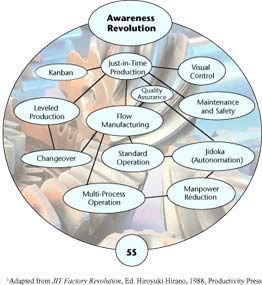People sometimes ask me to explain the difference between lean production and six sigma. The question is usually
phrased something like, "Should I use six sigma or lean production methods to improve my operations?" Before I tell you my answer, let me provide a brief background on these different
approaches to process improvement. Lean production is based on the Toyota Production System and usually includes the elements shown in Figure 1. When properly implemented, a
lean production system can dramatically improve productivity (by as much as 95 percent when compared with traditional batch-and-queue production systems).
Figure 1: Elements of Lean Production |
Lean production dates back to the post-World War II era in Japan. It was developed by Taiichi Ohno, a Toyota production executive, in response to a number of problems that
plagued Japanese industry. The main problem was that of high-variety production, required to serve the domestic Japanese market. Mass-production techniques, which were developed by Henry Ford to
economically produce long runs of identical products, were ill-suited to Toyota's situation. The lean approach (the term "lean" was coined in the early 1990s by MIT
researchers) systematically minimizes waste--called muda--in the value stream. Muda includes all types of defective work, not just defective products. Wasted
time, motion and materials are also muda. OK, so how does this relate to six sigma? To make a valid comparison, we
need a new definition of quality itself. By defining quality in terms of value rather than in terms of defects, we can see that six sigma quality involves a search for ways to reduce muda
. I propose the following definition for six sigma:  A general approach to reducing muda in any environment
A general approach to reducing muda in any environment
 A collection of simple and sophisticated methods for analyzing complex cause-and-effect relationships
A collection of simple and sophisticated methods for analyzing complex cause-and-effect relationships
 A means of discovering opportunities for improvement A means of discovering opportunities for improvement
The lean approach offers a set of solutions to
muda in a high-variety production environment. Six sigma applies to the problems addressed by lean but also seeks to solve other problems common to production. However,
because both six sigma and lean address the problem of muda, there is a great deal of overlap. The approaches should be viewed as complements to one
another. Some examples of this synergism are shown in Table 1. Table 1: The Synergy of Six Sigma and Lean Production
If you're facing a situation where lean solutions can be used (e.g., high-variety
production), you shouldn't hesitate to implement lean: It offers proven solutions to known problems. Six sigma methods will help you with lean, and they will
help you continue to improve when it's time to move into administrative and other nonproduction areas. About the author
Thomas Pyzdek is the author of The Complete Guide to Six Sigma (www.qualityamerica.com )
and a consultant in six sigma. Visit his Web site at www.pyzdek.com for more information on six sigma. E-mail him at Tom Pyzdek . |